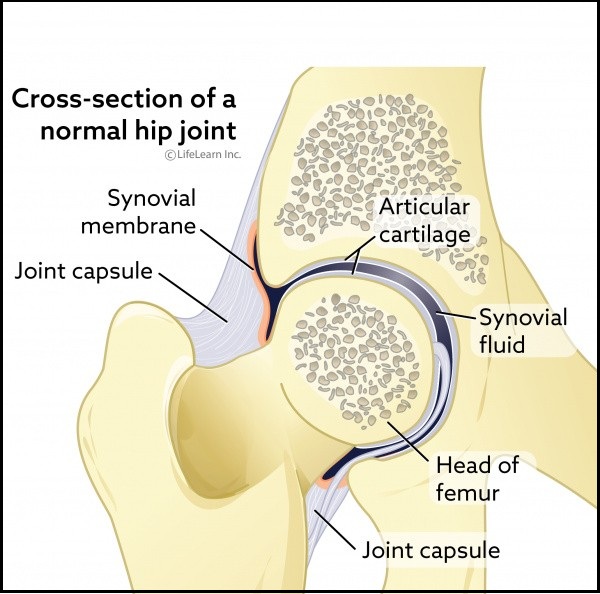Home | Medical Info | Understanding Osteoarthritis (Degenerative Joint Disease) in Dogs
Understanding Osteoarthritis (Degenerative Joint Disease) in Dogs
Keywords:
Understanding Osteoarthritis in Dogs
Osteoarthritis (OA) is a common condition in dogs, affecting 1 in 5 adult dogs and 80% of dogs over age 8. OA leads to joint pain, stiffness, inflammation, and reduced mobility, which can severely impact a dog’s quality of life. Common signs include limping, reluctance to exercise, stiffness after rest, and difficulty climbing stairs. Early detection and proper management can help slow disease progression. Treatment includes pain relief (NSAIDs, Adequan®, Librela®), joint supplements (glucosamine, Omega-3s), weight management, physical therapy, and environmental modifications. At Canton Animal Hospital, we offer comprehensive osteoarthritis care to improve your dog’s mobility and comfort.
What is a Joint?
A joint is where two or more bones meet, allowing movement. Joints are made up of:
Synovial membrane – Produces joint fluid to lubricate movement.
Articular cartilage – Covers bone ends, reducing friction.
Ligaments and tendons – Provide joint stability and support.
When cartilage deteriorates, bones rub against each other, leading to pain, inflammation, and mobility loss.
Featured Resources

We Welcome New Patients!
We're always happy to give your furry friend care at our hospital. Get in touch today!
Contact Us
What is Osteoarthritis (Degenerative Joint Disease – DJD)?
Osteoarthritis (OA) is a chronic, progressive disease where joint cartilage deteriorates over time, leading to:
Pain and stiffness due to inflammation and bone remodeling.
Reduced mobility as joints lose function.
Bony growths (osteophytes) that attempt to stabilize the joint.
"canine degenerative joint disease signs and treatment"
Signs of Osteoarthritis in Dogs
Recognizing OA in dogs early can help slow progression. Common behavioral and physical signs include:
Limping or stiffness, especially after resting.
Reluctance to walk, play, or climb stairs.
Difficulty rising from a lying position.
Muscle loss in affected limbs.
Increased irritability or sensitivity to touch.
Changes in posture or gait.
If your dog shows any of these signs, schedule an evaluation at Canton Animal Hospital.
"early signs of arthritis in dogs"
How is Osteoarthritis Diagnosed?
A veterinary evaluation, along with X-rays, joint fluid analysis, or advanced imaging, helps diagnose OA. Diagnostic findings include:
Narrowed joint space.
Cartilage loss and inflammation.
Bony growths (osteophytes).
Early detection is crucial for effective pain management and slowing disease progression.
"dog arthritis diagnosis and imaging"
Treatment Options for Osteoarthritis in Dogs
While OA cannot be cured, multimodal treatment approaches help improve quality of life.
Pain Management & Anti-Inflammatory Therapy
NSAIDs (Non-Steroidal Anti-Inflammatory Drugs) – Reduce pain and inflammation.
Librela® (monoclonal antibody therapy) – Monthly injections provide long-term pain relief.
Steroid injections for severe cases unresponsive to other treatments.
Adequan® injections – Help prevent cartilage breakdown and improve joint function.
"Successfully managing your dog’s OA means maximizing comfort and function while minimizing pain."
Joint Supplements & Nutraceuticals
Glucosamine & chondroitin – Help support cartilage health.
Omega-3 fatty acids – Reduce joint inflammation and stiffness.
Green-lipped mussel extract – Natural anti-inflammatory benefits.
Weight Management & Mobility Support
Obesity worsens OA – Maintaining a healthy weight reduces joint strain.
Low-impact exercise (swimming, leash walking) helps maintain mobility.
Raised food bowls and orthopedic bedding improve comfort.
Environmental Modifications for Arthritic Dogs
Non-slip rugs and traction mats help prevent slipping.
"An often-overlooked yet very important environmental modification is slip-free flooring. "
Ramps and stairs provide easier access to furniture or vehicles.
Heated bedding and warm environments help ease joint stiffness.
"best arthritis treatments for dogs"
Physical Therapy & Alternative Treatments
Additional treatments that support long-term joint health include:
Hydrotherapy (underwater treadmill) to improve mobility.
Acupuncture and laser therapy for pain relief.
Physical rehabilitation exercises to strengthen muscles.
Talk to our veterinary team about a customized arthritis management plan!
"alternative pain relief for arthritic dogs"
Featured Resources

We Welcome New Patients!
We're always happy to give your furry friend care at our hospital. Get in touch today!
Contact UsFrequently Asked Questions (FAQs)
Osteoarthritis is a progressive disease that requires ongoing management. Below, we answer common questions to help you understand the best ways to care for your arthritic dog.
